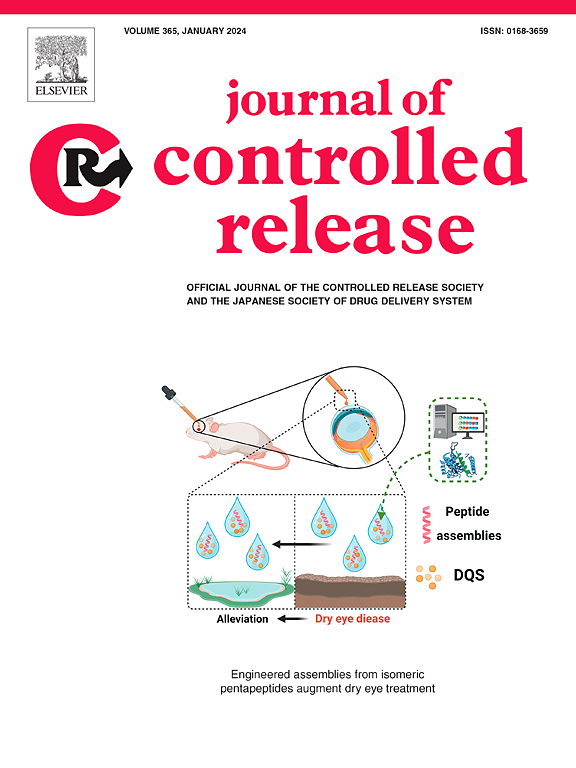In vitro-in vivo relationship and microstructural insights into long-acting levonorgestrel intrauterine systems
IF 10.5
1区 医学
Q1 CHEMISTRY, MULTIDISCIPLINARY
引用次数: 0
Abstract
Despite the proven high contraceptive efficacy and safety of levonorgestrel intrauterine systems (LNG-IUSs), no generic versions are currently available in the US market. This is primarily due to the challenges in achieving qualitative and quantitative (Q1/Q2) similarity with the reference listed drug (RLD) stemming from structural and mechanistic complexities, as well as the ultra-long duration of action (up to 8 years) of IUSs. The extremely long-acting release duration makes it difficult to navigate formulation decisions with even a modicum of speed. The burden to demonstrate bioequivalence hinges on awaiting years of release testing. Additionally, variations in microstructural arrangement can affect key formulation characteristics, potentially affecting bioavailability and bioequivalence. To address these challenges, this study presents a comprehensive reverse engineering analysis of commercial LNG-IUSs (Mirena® and Liletta®), including polymer crosslinking and physicochemical and mechanical characterization using FTIR, ssNMR, DSC, TGA, and SEM-EDX. X-ray microscopy (XRM) and focused ion beam-scanning electron microscopy (FIB-SEM) with AI-based analytics were employed to study microstructural changes in unreleased and post in vitro release samples, comparing commercial and in-house IUS variants. Real-time in vitro release testing was conducted for over 7 years for Mirena® and the in-house IUS, and up to 4 years for Liletta®. Additionally, an accelerated release method was developed, enabling full drug release within 100 days. Post-release analysis included assessment of levonorgestrel distribution, particle size, porosity, and structural changes across IUS layers, with findings revealing compositional differences that impact release kinetics.
Notably, this study is the first to report an in vitro-in vivo relationship (IVIVR) for ultralong-acting IUSs, correlating in vitro drug release data with in vivo LNG release profiles in humans. The established IVIVR offers a predictive tool for assessing drug release behavior in clinical settings, potentially reducing the clinical burden and accelerating drug development timelines. The current research offers a roadmap for manufacturers to refine their formulation and manufacturing processes to match target attributes. It is anticipated that this research will enhance public access to these highly effective long-acting reversible contraceptives.

长效左炔诺孕酮宫内系统的体内外关系和微观结构研究
尽管左炔诺孕酮宫内系统(LNG-IUSs)已被证明具有很高的避孕功效和安全性,但目前在美国市场上还没有通用版本。这主要是由于在实现与参考上市药物(RLD)的定性和定量相似性(Q1/Q2)方面的挑战,这些挑战源于结构和机制的复杂性,以及iu的超长作用时间(长达8 年)。极长的作用释放持续时间使得它很难导航配方决策,即使是一点点的速度。证明生物等效性的负担取决于等待数年的释放测试。此外,微观结构排列的变化可以影响关键的配方特性,潜在地影响生物利用度和生物等效性。为了应对这些挑战,本研究对商用LNG-IUSs (Mirena®和Liletta®)进行了全面的逆向工程分析,包括聚合物交联以及使用FTIR、ssmr、DSC、TGA和SEM-EDX进行的物理化学和机械表征。采用x射线显微镜(XRM)和聚焦离子束扫描电子显微镜(FIB-SEM)以及基于人工智能的分析技术,研究未释放和体外释放后样品的微观结构变化,比较商业和内部IUS变体。实时体外释放测试对Mirena®和内部IUS进行了超过7 年的测试,对Liletta®进行了长达4 年的测试。此外,还开发了一种加速释放方法,可在100 天内完全释放药物。释放后分析包括评估左炔诺孕酮在IUS层中的分布、粒径、孔隙度和结构变化,结果揭示了影响释放动力学的成分差异。值得注意的是,这项研究首次报道了超长作用iu的体内外关系(IVIVR),将体外药物释放数据与人体体内LNG释放情况联系起来。已建立的IVIVR为评估临床环境中的药物释放行为提供了预测工具,有可能减轻临床负担并加快药物开发时间表。目前的研究为制造商提供了一个路线图,以改进他们的配方和制造过程,以匹配目标属性。预计这项研究将促进公众获得这些高效、长效、可逆的避孕药具。
本文章由计算机程序翻译,如有差异,请以英文原文为准。
求助全文
约1分钟内获得全文
求助全文
来源期刊

Journal of Controlled Release
医学-化学综合
CiteScore
18.50
自引率
5.60%
发文量
700
审稿时长
39 days
期刊介绍:
The Journal of Controlled Release (JCR) proudly serves as the Official Journal of the Controlled Release Society and the Japan Society of Drug Delivery System.
Dedicated to the broad field of delivery science and technology, JCR publishes high-quality research articles covering drug delivery systems and all facets of formulations. This includes the physicochemical and biological properties of drugs, design and characterization of dosage forms, release mechanisms, in vivo testing, and formulation research and development across pharmaceutical, diagnostic, agricultural, environmental, cosmetic, and food industries.
Priority is given to manuscripts that contribute to the fundamental understanding of principles or demonstrate the advantages of novel technologies in terms of safety and efficacy over current clinical standards. JCR strives to be a leading platform for advancements in delivery science and technology.
 求助内容:
求助内容: 应助结果提醒方式:
应助结果提醒方式:


